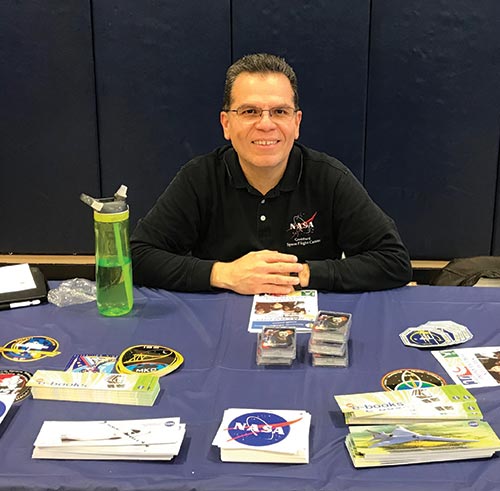
Juan A. Román is deputy director of the engineering and technology directorate, NASA/Goddard Space Flight Center in Greenbelt, Maryland. He is one of several Adventists playing a role in science’s continuing exploration of outer space. He recently agreed to answer a few questions. —Editors.
As a child, who were some role models who inspired you to consider a career in aeronautics?
I was almost 5 years old, and I remember watching the landing of the Apollo 11 Lunar Module with my family on a small black-and-white TV, and Neil Armstrong and Buzz Aldrin walking on the surface of moon. That was a very impactful event for me. I wasn’t able to understand completely what was going on, but that event planted the initial seed. After that, space and space exploration captivated me.
As an Adventist, were you encouraged to pursue a career in science (against some fears that it might lead away from faith)?
I grew up in a very devoted Adventist family. Since I was very young, learning about God and His love for us was always front and center at home. My parents’ education philosophy was: “Train up a child in the way he should go: and when he is old, he will not depart from it” (Prov. 22:6, KJV). They provided me with a solid Christian foundation and always encouraged me to follow my dream to work at the National Aeronautics and Space Administration (NASA). They inspired me to be an example to others, and that’s what I try to do as I work at NASA.
I decided to study engineering very early. When my brother was studying chemistry, he had a friend who was studying engineering. Every time my brother’s friend would visit us at home, he would tell my brother about the classes he was taking and the problems he was assigned to solve. I became fascinated with engineering, and, combined with my passion for space exploration, working at NASA became my goal.
In 1988 I graduated with honors from the University of Puerto Rico at Mayaguez with a Bachelor of Science in Mechanical Engineering. I immediately started working at NASA’s Goddard Space Flight Center in the Space Simulation Test Engineering Section as a test engineer. While working, I continued studying and earned a D.Sc. in systems engineering and technology management from the George Washington University. Throughout my 30 years at NASA I have occupied multiple technical and management positions, each one encompassing greater visibility and responsibility. As deputy director of the engineering and technology directorate, I provide leadership to more than 1,200 civil service engineers and 2,000 contractors, who provide multidiscipline engineering expertise to our many science and exploration missions.
How does the environment where you work challenge or affirm your faith?
I have to say that working at NASA has made my faith in God even stronger. There are more than 10 billion galaxies in the observable universe, with an average of 100 billion stars per galaxy, and potentially billions of planets. Earth is a unique place: the only planet we have discovered that has life.
When we study earth and the different complex processes that take place in perfect balance to support life, I see the hand of God in all of it.
What are one or two of your most vivid memories over the course of your career?
A few years after I started working at NASA, I was assigned as test engineer for the composite infrared spectrometer, which is one of the 12 science instruments on the Cassini mission designed to carry out sophisticated scientific studies of Saturn. I worked with an excellent team of scientists, engineers, and technicians to build, test, and deliver the instrument to the Jet Propulsion Laboratory for final integration into the spacecraft and launch. That was a great experience for a young engineer.
The Cassini mission was designed for a lifetime of only nine years (six years to get to Saturn, and three years of scientific observations from the planet). But it lasted for 20 years, much longer than anticipated. Cassini represented a staggering achievement of technical complexity, and revealed the beauty of Saturn, its rings and moons, inspiring our sense of wonder. Its many discoveries prompted scientists to rethink their understanding of the solar system.
What would you say to someone considering a career in the aerospace industry?
The space industry is incredibly diverse and growing rapidly. It provides many opportunities for everyone who is interested in the science, technology, engineering and mathematics (STEM) related fields. There are also many non-technical roles associated with the space industry, from human resources, public relations, law, and many more. The industry offers high-paying jobs and rewarding careers.
My advice is to follow your dreams and be the best you can be in everything you do. Never give up.